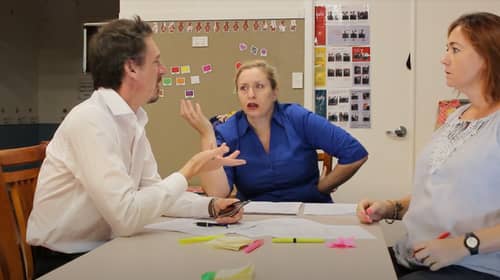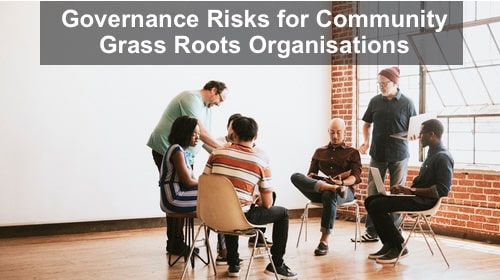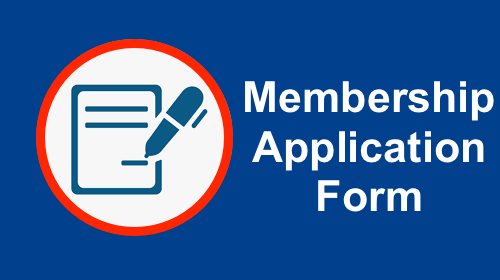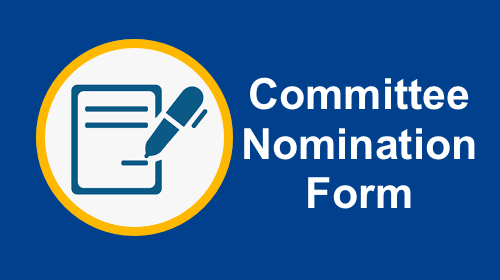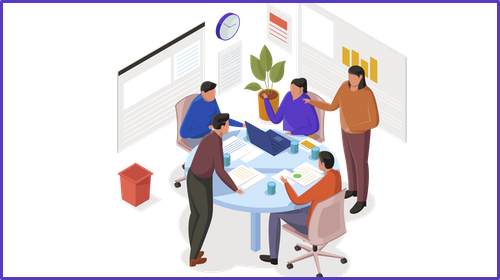How to Run Your AGM
Watch our governance expert Natalie Bramble as she explains how to run a smooth and legally compliant AGM
Authored by: iClick2Learn Team
Translate Text
Fabulous, welcome everyone tonight. We’re talking about how to run your AGM. Before we get started, I wanted to say thank you and welcome to all our wonderful volunteers. And for those who are watching the catch-up replay of the webinar, the work you do makes such a difference in your community. And I know you all love it, otherwise you wouldn’t be doing it. But, you know, it’s just nice I think to take a moment and say, yeah actually, I do make a big difference. And the information that you’re able to get from today’s webinar and the conversations we’re having as well. The great thing about that is no doubt, you’ll also be sharing those with your community members, which is what we really love. So I also wanted to acknowledge that we’re streaming today on the land of the Dhubu-ga, which is in Dubbo, New South Wales. And we’re in the home of the Wiradjuri. So, acknowledging all those from other parts of Australia and the traditional owners of our land, sea and sky, who are joining us today and anyone who does identify as Aboriginal Torres Strait Islanders watching as well. Thank you for your contribution to our culture.
Today, we’re going to be talking about how to run an AGM. We’re pretty much going to be going through these areas, for those of you who may not know we do, particularly where there are images on screen, if we’re talking to images, we do an audio described version and that makes sure that it’s accessible. Just in case people are either listening with their mobile phones or perhaps they do have a visual impairment. So if you do hear me describing something, that’s to make sure that we’re providing an inclusive environment for everybody. So we’re going to be going through the AGM from preparation, sort of looking at the rules, the agenda, looking at resolutions, we also going to be talking about voting and proxies and those sorts of things that happen at meetings. But also thinking about how do we manage difficult situations as well, things that do come up. So feel free to challenge me on any of those. And, you know, if you’ve had some situations that occur, feel free to put that in chat. And it’s always useful for us to also hear from our wonderful peers as well and the people on the session and what you’ve experienced also. And I’ll open it up to some sharing if you’d like to do that in the recording as well. And then we’re going to finish up on that post-AGM. ‘Cause like any event, it’s not finished until the cleanups done. So that’s that post-AGM part we’ll be going through. Lets talk first though about preparing for the AGM. There are a few things that we definitely do need to consider. One of the things I wanted to touch on, is some organisations, particularly service-based organisations, the members of their organisations may actually only be the decision makers. So the board and the committee. So you may not have a broad membership. And sometimes those decision makers get confused about what their membership role is, versus what their governing role is. So it is really important that they understand that whilst they are directors, they still need to have a members AGM. So this is a members requirement that they have to meet.
As much as it is as a director’s requirement. And so, you know, if this is you and the AGM is one of your agenda items on a committee or board member agenda, then just make sure that that is a separate agenda. So the AGM is dealt with separately. It’s one you’d be surprised at the number of times I’ve found that, that people are dealing with that as sort of board business in the nature of a general board meeting. So it is a completely separate thing. One of the things for some of us is, is it going to be in person, or is it going to be virtual? I’m dealing with one at the moment actually, for an organisation where we’re going to be using multiple methods for people to connect and engage. And I think that’s one thing then, whilst many of us have been forced onto the virtual environment in meetings because of the situation. It’s also opened up some opportunities to engage people that otherwise may not have attended. So it is something to consider if you’re in the fortunate position of having it in-person that’s fantastic. But it is useful to consider, is it actually worthwhile having a virtual component to your event as well? And so you can do that by having people present and then you could use Zoom for example, or another video streaming service, Microsoft teams is another one, et cetera. You would just need to, from a technical perspective, have somebody managing and monitoring that virtual environment, but you can certainly have it projected up on the screen, or even connected to a TV, or even a laptop if need be. The challenge of the laptop is everyone won’t be able to see everybody, but they’ll still be able to hear and participate and engage. There are some things that you will need to think about from virtual perspective, if you have both virtual people present, as well as in-person, is that voting and how you manage that. So let’s talk about that in a little while when we talk about voting and what happens. We definitely should be thinking about who needs to be there. You know, an AGM sometimes it’s a bit, mm yeah, it’s an AGM, or some people might think, I’m not going to the AGM, ’cause I’ll get a job. So it’s useful to think about, well, how do we structure our AGM. There are a lot of different ways that I’ve been involved in over a lot of different organisations and thinking about our AGM. And sometimes it’s an opportunity to launch something and have an AGM as well. An opportunity to have an AGM, for those of you that maybe have conferences or workshops to have an AGM at the same time. To have an AGM where you’re presenting information about the success and the achievements and focusing on that aspect and engaging your donors and funders and community supporters and bringing them along to kind of a celebrator connection. And particularly if you can have it in person and you’ve had a bit of a delay since being in person, that’s a good opportunity. So you could call it a connecting event. So there’s a few different ways to think about that AGM. Another way is, you know, we’re having a planning session, so we’d really love your important insights and feedback. And so that’s another way of engaging people. One of the things that I really do firmly speak to and encourage, is that three months before the AGM we’re starting to have conversations with our board members, our committee members, about who is standing again. And so one of the things to have a look at in your constitution, is called terms of office. And so terms of office should be covered in your constitution.
Some of you might not have a term of office, it is just simply when someone stands down at an AGM and people are voted up. But others may have a term of office and it might be for a maximum of three consecutive years, for example. Some organisations terms of office is a maximum of three consecutive years and two terms. So there are different ways that this is considered. So have a look at your constitution and see if it covers anything around terms of office and be aware if somebody’s term of office is coming up. Or as I say, those conversations with people that they may want to step down, that it’s really useful to know that in advance. Because then you can say, okay, well, you know what, we’ve got to make sure that we’re being proactive and reaching out to community members to bring them on board. Asking for questions and speakers ahead of time can help you coordinate on the day. And I can see some questions in chat as well, I’ll head to. Yeah, how do we encourage people to actually attend the AGM? So one of the things that I think is really useful in communicating that, is consider the difference that you make to the community. Without you, what does it look like? We could often go, oh yeah, well we go along and we do what we’re doing, but if you actually stop and say, hang on, if this organisation wasn’t here, then what would the community be missing out on? And so you can use that as a key message. Come along to the AGM. It’s really important if you want to make sure X, Y and Z, organisational services, or we still continue to support, if you’d like to have a voice. Using that really engaging language is really important. So that can be really helpful. Another question, is it worth inviting non-members to the AGM? Yeah. And this is a really great one. Because it is about what you’d like to do. So for AGMs, you can either have it private, so voting participants, attendees, members only. Or you can have it open to the community. And I think that really comes down to what’s the nature of your organisation. If you really do want community support, if you want to engage community, if you’re looking for committee members and board members from the general community, then it’s definitely worth inviting interested members of the community. And I’d also think about for a lot of councils, they have a new residents engagements. So it might be new residents night, for example. So I’d also think about how you can connect with people that have recently moved to the community. You know, maybe your local neighbourhood centre is the recipient of people who are moving to the community. And they’re saying, oh, you know, we just want to know what services are around, et cetera. So you can also reach out to some of those new residents and put that out there for them to come and find out more about their community and what you’re doing. And again, when it’s just an AGM and just a meeting, when it’s proposed as a meeting, it kind of looks like and sounds like work. So when we think about proposing it as a different way, come out and find out more about X, Y and Z. And you also need to, if you’re giving that perception, that this is a launch event, or a celebration event, then you’ve still got to have the AGM part of the meeting. But you’ve got to really give focus on what it is that you’re positioning. And yeah, great point Kim’s shared in chat. We always invite the CEO of the local council and the counsellors, always great. Think about those influencers, also I’d suggest your local members, federal members, you know, even if they don’t come there’s still an acknowledgement, which is really important, ’cause you never know when a funding applications going to come across their desk as well. So that’s always useful. Had a really great question around, should we have an independent returning officer? So a returning officer is what we’re talking about here, is in effect somebody who’s managing the voting component, if you like and the nomination component of the meetings. So when we think about a returning officer, there’s a couple of considerations. First of all, if you think there is going to be a bit of a contentious issue arise, I really do support independence. If it’s going to be a challenging situation, then independent chairs and returning offices are great, particularly in an environment when, what I call is, the power balance rests with the members. So in some organisations, you know, you’ve got the power balance that rests with the board and committee, particularly if there are only the members. You know, it’s only those individuals that are the members, but when you actually have a very strong membership base and a very strong power base, then having an independent is a really good idea, because what we’re talking about in essence, is transparency around a popular vote. And so that’s always a healthy thing to do. So really encourage and another great thing, if you’re you’re positioning an AGM as a launch or something, is having those local members and giving someone else the opportunity to shine. You know, we’d like you to launch this on our behalf. So that’s always really useful. If you are going to be doing a virtual environment, you really do need to spell out what the protocol is for that and how you’re going to manage that. And think through everything.
What happens if we had somebody that just would not, you know, they kept unmuting themselves, et cetera. You know, even if we ask them to mute, what would we do? So you really do need to have steps and stages for handling that. How are we going to handle voting is one we’ll talk about in a moment, but how do we handle that engagement piece as well? You know, is it worthwhile to break them up into separate breakout rooms, conversations, or breakout rooms for voting decisions? So we’ll talk a little bit more about those. Some of you maybe looking at virtual and I was talking with someone the other day that said, actually, they’ve discovered that the value of virtual for them and they think there’ll be moving virtual forward in the future. And this is an organisation that’s Australia-wide and has a few members dispersed across the states. Just want to point out a few library resources here. We’ve got a Meetings via Technology video, that you might find quite useful. And of course, there’s also a useful video on attracting new committee members as well. So just pointing those out to you, they might be worthwhile having a look relating to this information. Another thing that you need to consider is how do you track attendance. Now, particularly if this is virtual, people join when they’re Sally The Cat, or something along those lines, because their daughter or their son has recently been using their Zoom account for schooling. So some unusual name pops up. So think about how you’re going to record attendance. Particularly if for virtual. You also need to think about how you’re going to identify voting rights. And I want to talk a little bit more about this from a membership perspective. It’s really important that one of the things that we do pre-AGM, is update our members register. Make sure that our members have been ratified by the committee or board. So it’s gone through that approval process. In some committees and boards, they might actually delegate this authority to their manager. And so their head person, manager, CEO, coordinator. And so if that’s the case, make sure that it’s gone through that process and that there can’t be any membership or validity challenged. You know, it’s always useful to do these due diligence checks pre, isn’t it? And then think about new members. And what’s the last date and time before the AGM, that you’ll actually accept new members. And I’ll give you a couple of examples. There are some organisations that are like, oh, that’s fine. We’ll accept them right up to the AGM time, or half an hour before. And half an hour before the AGM, we’ll hold a committee meeting. And our sole purpose of that committee meeting is to ratify and accept members, new members. You know, members that are renewing membership, unless there’s an issue with their membership. That’s a fairly standard one. You can put a process in place and a decision that says, any renewing members are automatically accepted, but particularly for the new members, it’s important that you do that ratification process. And then there are some others, I’m actually supporting an organisation at the moment, where we’re requiring that new members return their membership no later than two weeks prior to the AGM. So this allows some of the background work to be done, to prepare. So just think about that. What’s that timeline? There has been some cases where, and it’s always that it’s okay unless somebody has an issue thing. So there has been some cases, for example, where people have been voted in, but they’re actually not a member. Or they had a vote and they’re actually not a member. And that can actually, you know, be challenging situation to do recounts. Because if it doesn’t comply with the constitution, its unconstitutional, which is illegal, which means we kind of have to start from scratch. So always best to make sure that we follow that process. I’ve talked a little bit about, you know, how to think about the AGM a little bit differently. There is also, for those of you maybe that are looking for membership forms, there’s also a membership form. While I talk about that, I’ll just bring that up. There’s a membership application form in the library. And the other form that you’ll also find is a committee nomination form. And there’s an article that actually goes through those forms and gives you information about how to use that using an example. And I think actually we use the, from memory I use the Western Australian Associations Incorporation’s Act, but you’ll be able to apply those and see what those clauses are in it. And that’s the other thing you need to think about is, okay, so when we think about a timeline, how long pre-AGM will we accept committee or board nominations? Now, for some of you, there are some additional requirements here around nominations, particularly relating to making sure that they are deemed an appropriate person to hold office, things like, you know, that they haven’t committed fraud, or been accused of a criminal offence, et cetera, not declared bankrupt. So that committee nomination form, even if you have a committee nomination form, worthwhile having a look at from the library, because we do actually talk about those aspects and we ask the individual to confirm that they do comply in that they, you know, they are deemed to be eligible as per your constitution and as per those requirements. And so it is worthwhile doing that.
There are some organisations that do do some due diligence around this, larger organisations for smaller organisations, you know, just asking the individual can sometimes be enough for your committee or board just to say, well that’s fine, we’ve asked them if they comply. And if at some time you find out they don’t, you can then deal with that. But the important thing here is to ask what the cutoff is, you know. Are you happy to accept nominations from the floor, for example. Which is, we’re in the AGM right now and we’re asking for nominations from the floor. Or would you like to accept nominations 24 hours prior or a week prior, to give you an idea as to, you know, have we got enough, do we need to go and do some more work to go and ask for committee positions? Do we have enough nominations, et cetera? Or you might do a mixed model. We’d prefer them by this date, but we’re also accepting them from the floor. I think it’s always useful and just a point, this isn’t about engineering our members, our board, or committee. This is really about giving you an understanding of, do you have the right people with the right skill sets that are nominating for positions? Do you have enough positions? So in other words, is there any work you’ve got to do, pre? One of my wonderful mentors, Gail Eckford, was sitting on a meals on wheels committee and, you know, it’s an essential service, but it’s not for many, not something that people go, oh, you know, this is really exciting and innovative. So there is a degree of attraction for certain things. You know, some people may prefer support a children’s charity, for example, whatever it might be. So it’s a very fundamental service based committee. And you know, they ask that question prior and did some training and I asked that question prior and they discovered actually, if they didn’t do something about getting committee members, then they won’t have enough for the AGM. Gail simply did one thing. She went and talked to people in the community where the business had, you know, they had staff that had a skillset. She shared the message about the impact that it makes, she shared stories about the people that they’re working with. And it came to the AGM meeting, so they have seven committee, or they had at that time, seven committee meetings, they had nine nominations from the floor. So, you know, they went from only having three, you know, which at that time was less than they were legally required to have. And oh my gosh, what’s going to happen, to, wow, we’ve actually got more than we were looking for. So that’s a really great one. Have a really great question. I love this question. How do you handle it if someone nominates for your committee, but they’re not suitable. And that’s why this board nomination process is really important. When we think about board nominations, you can actually put a process in place whereby your particularly stating that you’re looking for certain skills, or experience. And so you can use that as the basis for promoting. And so by promoting what you’re looking for, it’s giving those people the understanding of what you’re not going to consider. So that’s a subtle way of doing it. The other way of doing it is on your nomination form, actually asking them to tick a box on which of those skills or experience they offer and asking them to provide information about that. And if it’s something like a commitment, getting them to say how much time, or what will I specifically commit. So that can certainly be a helpful process in managing that. So hopefully that’s helped you. You think about that as well. That’s beautiful. Don’t, oh yes a great question. Actually, I’ve had a couple here I’ll look at. Don’t most constitution state when the nominations close and how people nominate. So the answer to that is no. There may be when we look at general model rules, model constitutions, you know, this is the beautiful thing about this space. And many of you would know, being involved in a couple of different organisations. As long as they comply with legislation, they can put in whatever other rules they’d like. So there certainly will be constitutions. Why it’s so important to look at some of the clauses. And I’ve got some examples actually using South Australia model rules. I was nearly going to use Western Australia tonight, but I thought I’d used South Australia. So it’ll give you an example of what clauses to look for, but then that is why, you know, it is so important. I myself, was having this conversation with this organisation I’m helping within November to run this sort of public meeting, which is an interesting situation I won’t go into, but it does require a little bit of, you know, making sure that we’re very compliant, et cetera. And I actually have the constitution up in front, while we were going through, okay, what does this look like? Developing our AGM checklist on what we had to do. So yeah, definitely why it’s so important. The other thing that you might have and I’ll just speak to this for a moment. If it’s not in your constitution, you might actually have what’s called bylaws. Sometimes they’re kept with the constitution. They should always be kept with the constitution. I’ll give you an example. A netball club. They’ll have bylaws, mostly it’ll relate to things like competitions, things that involve members. But there may be some bylaws that relate to how you run meetings, how you run your AGM and the process. So always useful to look at that. And you’ll see generally in those, you’ll actually see those specific details about returning officers. So always have a look at that as well. Should existing members complete the membership annually? Yes, definitely. Unless you have stated otherwise. So there’s no reason why you couldn’t, for example, welcome members and state in your form that this is a three-year membership. But unless otherwise, they should complete a form because this is them giving permission. It’s like nominating someone. Oh, I nominate Natalie for chair. Well, unless I accept the nomination, it doesn’t mean anything, right? So this is them filling a form out to say, yup, I wish to rejoin as a member. And then here’s my payment for membership. So always useful to do that. You know, there have been situations where, for example, someone said, ah look, Natalie’s not here. I’ll pay for her renewal so we can move forward. But in actual fact, I didn’t want to be a member that year. So, you know, then we’ve got to uncover some of those. So always useful to do. And so those forms I mentioned earlier that are in the library, might be helpful for you as well. And the article kind of goes through how to use them. And it does speak to some of those skills things that I talked about, you know, somebody nominates that is unsuitable. It’s useful just to expand on that further, it is useful to think about, if your organisation is looking to make sure that they do have suitable members of the community nominate, rather than just, you know, that’s great, they’re passionate, let’s get them involved. But it is useful to think about a formal nomination process, because you’re able to amend that and change that annually.
So the article for those forms, well it goes into a little bit more detail, but you know, I’m always here and you have my direct contacts, find the email that I send to you and you can always ask me questions. So let’s have a brief look at the rules. And these are some things that I’ll ask you to have a look at in the constitution for the organisation. Now, as I said, I’ve just used the South Australian model rules for this. So when do you need to hold it? And you will find in your constitution, and it may be in a couple of different areas, because you know, each state is slightly different. So for example, if you’re using the WA model rules, it’ll actually be under notice of meetings. If you’re using South Australian, then it’s general meetings. Some of you might have a custom constitution and it just deals with notices as a separate thing. So find either notice periods, or annual general meetings. If there is a notice period in your AGM, that takes precedence over any other notice period. It’s generally pretty consistent. And when I talk about these things, I always preface that this is just speaking to a general term, not to your specific rules, because obviously I haven’t seen them. But you can see here that this AGM in South Australia, “within five months after the end of the financial year” it should be held. You know, New South Wales, I think it’s six months. So, you know, and that’s again, yours may be slightly different. So the financial year is an interesting one. When is the financial year? Financial year of an organisation doesn’t necessarily mean financial year, as in, you know, 1st of July to the 30th June. For some organisations, their financial year is still calendar year. So, you know, it’s important to know that and put that in context as well. So that’s one we’ve got in this case. We’ve got five months to hold it after the end of financial year. And we’re just going to say that the financial year in this case is the 30th of June to the 1st. So the notice period, so what notice is required, now in this case, we have a notice period of at least 14 days of the notice of a general meeting. And now this is a great example in the South Australian model rules. Where they spoke about an annual general meeting and the holding of an annual general meeting. But the notice period is actually only in one section. And so the notice of meeting in this case also applies to the AGM, which is an interesting one, but it’s fairly standard. If you’ve got a resolution, pretty much the standard process is 21 days, if there is a resolution. And if there’s not a resolution, 14 days. So that’s actually fairly standard in my experience across a range of different organisations. And the important thing I think here, is that if yours is different, it’s okay if it’s more time, that’s sort of if it’s 30 days notice with a resolution, or just 30 days notice full stop. Well that will be okay. But if it says seven days notice, if there’s a shorter period and you want to check it, it’s always useful to go and have a look at the model rules of your state, to just say, oh what does that stay, or the model constitution. So in this case, being the South Australian model, 21 days prior to the date of the meeting, if there’s a special resolution, but 14 otherwise. There’s also a couple of other things here around notice and particularly talking about how the notice is to be served. So it does state that the notice may be given personally, or by sending it by email or post. You know, some of the particularly older constitutions may actually negate or miss out the fact that these modern forms of emails may not apply and it may actually state by post. So one little tip there is to, if you are having to post a notice, just make sure you give breathing time for them to deliver it. So I’d give a couple of extra days if you’ve got members in different states, I’d actually allow probably an extra four to five days, just to make sure that they do adequately and receive notice. So you’ll also receive the quorum, so this is also an important thing around quorum. Now, an interesting one on quorum, you know, that’ll be a new constitution as well. But there will be, in your quorum requirements, it’s either going to be a percentage or a number. But there’s a little word that makes a difference when you talk about quorums for AGMs, and it’s the word called present. And I’ll give you an example. A quorum is, you know, to make a decision, is 50% of members present. So this particularly applies, for example, if we’re talking about voting. So if a vote is to be held, then a vote is deemed whatever percentage again of members present. So the word present changes it considerably. Imagine you’ve got a hundred members and you only have 15 people that have turned up to the AGM, but you’re required to have 50% of the members in order to constitute a quorum. Do you see how that changes? Versus 50% of those present to be members. So that word is an interesting one, always useful I always say, to go back and have a look at the constitution.
It’s about making constitutions and rules work for the practical every day, isn’t it, rather than thinking, oh my gosh, okay, that means we’ve got to get 50 people here, how do we do that? So that’s a really valuable one to look at, both from a quorum perspective, but also from a voting perspective as well. So the other one I wanted to, it’s exactly the same slide. The other one I wanted to reinforce here though, is what if there’s no quorum, what’s the alternative? So if there isn’t a quorum, again the alternative will be outlined in the constitution. And it’s generally that if a quorum not present within 30 minutes of the meeting starting, you then generally hold it the next week, the same day, the same time. So giving everyone notice. And then, you know, if there’s no quorum at that point, then that’s a conversation about is the organisation still relevant? Perhaps the organisation actually needs to look at itself and what it’s doing for its future. Another one is, and this speaks to the question we had about returning officer and if bylaws have anything in particular about how meetings have to be managed, you know, how is voting managed? So particularly if you’re looking at a virtual environment, maybe it’s a poll. If you’re, for example, having some people present, some people virtually, how do you differentiate those voters and just interested parties or supporters. And then how are you actually going to capture that vote, because you will need to have a record of that vote. Now it’s perfectly, you know, I’m not saying that you need to screen capture anything, particularly if it’s a public vote. So if you were all to say in chat, okay this is who we are. And then I would say, okay, well as secretary I’m saying that there is X, Y, and Z number of votes for yes and X, Y votes for no. Could you please confirm that? And then if that’s confirmed, could I have that passed? But if it is a silent vote, then that’s when you need to think about how to manage this. You know, how do we manage this process where it is a silent vote. The other one to think about as well, is proxies. I don’t know if that applies to anyone joining or listening in, but proxy votings is an important one as well. And when we think about proxy voting, you know, how is that handled? Is it okay for me to send an email to say, oh look, I’d like to give Jack, who’s going to be there on my behalf. And I’d like to give him my proxy.
There’s also two types of proxies I want to speak to as well, because proxies can be an issue when there’s power play. So if, for example, we allow proxies. Then I, as a member, I know that there’s 15 people that aren’t going to be there, but all I want something passed. And so I’m going to go and see them and ask them if they’ll give me their proxy and then I’m going to use those votes and vote on their behalf. Effectively, that’s what can happen, particularly when it’s an open proxy. But if it’s a prescribed proxy and if proxies do apply, I really do strongly encourage and do you know what, next week we will have, I will actually develop a form for proxy voting, that is a prescribed form for you. So if anyone this applies, by the time you’re watching this you should be able to to Google the library for proxy form and you’ll find it. A prescribed proxy actually lists the agenda items and asks them to nominate how they vote. And so that can restrict me using other people’s votes, proxies, for my own purposes. The other thing that you can do is you can minimise the number of proxies that any one person shall hold. So that’s also useful as well. And that stops that power play. Such as some things I wanted to mention around proxies. They’re great. And they can enable people to engage. But just like virtual, you know, virtual meetings, most of you probably have modified your constitution since Zoom, or the quick start of Zoom in COVID, but just like virtual, it’s great, but it can be misused. So it’s just about thinking about, okay, how do we manage that? Now I want to just talk about the purpose of the AGM as well. So the purpose of the AGM is again, your constitution will outline specifically. These are pretty consistent. What I’m going to read out is pretty consistent in terms of what the purpose is. It is to confirm the meeting minutes of the previous AGM. And so they’re generally sent out with the AGM notice. These are the previous minutes of the AGM. And then of course, any special general meetings that have been held since. There’s often one that’s kind of missed, is those special general meetings. The election of committee members, the appointment of any auditors, if it’s required your constitution, for some, it doesn’t apply at all. So you won’t need to worry about it if you’re not a charity and you don’t have to have that, for example. And it’s to pass financial minutes and any other business required. So that you’d put forward a resolution, et cetera. So it’s really important when you think about that purpose of the AGM that you’re covering off on those, that will form part of your agenda. Just had a question. What happens if motions are changed on the night? How does that affect proxies? The proxies stand as they are. So if a motion changes significantly, if a motion isn’t, you know, you’ve put a resolution and that resolution has been voted by the majority of members not to apply, then that’s struck from the voting. So hope that that answers the question as well. And then just, you know, your special resolutions, just make sure if you’re getting special resolutions to vote on, that they’re sent out in the business papers as well, particularly for absentee votes, or proxy votes as well. And so a couple of other resources in the library that will help you. So “Getting to Know Your Constitution” course as well. And there’s an interesting one on audit. So if audits apply, or you want to know a little bit more information on audits, we actually talk about the different levels of audits for organisations. There are essentially three different levels. So it’s a quick little video series, a couple of minutes each, I think, that goes into those. So that may be useful for you. So from a reporting perspective, generally speaking, it’s the chair and the president’s report, secretary’s report, our financial report, which is our auditor, either presenting or our treasurer presenting, but importantly, it’s about celebrating the wins and sharing the lessons. You may also want to have a report as well, if there’s a particular, you know, if you’re a committee, but you know, one of the biggest things that you have is an event.
So you may also want to have a report from your event coordinator, or even from the manager of your service, that can be also useful also. And always useful that these don’t need to be provided in advance. They can be verbally shared, but it’s always useful to then share a snapshot of that after the AGM, with members of your community and people that weren’t present as well. Particularly about those wins. They often kind of get lost in the story. So, you know, particularly making that shine, the difference that you made. I talked about the nomination and who’s standing for another term, to sort of get that up ahead of time. But also this is where you’ll look at the appointment of, so how many committee members do you need? Who do they need to be? And again, this is something that you should have a little at prior, three months prior to the AGM is great, because you’ve got a really good handle then around the numbers of committee members that you need. And it’s always useful to do this work three months prior, because what it will also highlight for you is if there is anything that, you know, you would like to propose, any change in a constitution, why not do it at the AGM as well? So that’s also why it’s really good to start looking at these prior. Now when you’re thinking about who’s on your committee or board and what positions you have to nominate, there is one that often gets missed and that is for some states and territories, what we call a public officer role. So for example, I’ll use se New South Wales. Under New South Wales Associations Incorporation’s Act, you’re required to have a public officer. And that public officer, the role is like a company secretary, for example. So Department of Fair Trading and Attorney General, who are the regulators, need to know who do they speak to if they’ve got questions or concerns. Also, you know, if there are any proceedings that need to happen, et cetera, they need to know who that person is that receives information. The public officer legally is responsible to make sure their information is updated. And is also responsible to make sure that they have copies of the recordings, or the official records of the association. And so when it comes to AGM time, you know, people, yep, president, secretary, treasurer, all those other roles, they know that’s in the constitution. But then at some point you’re going to say, oh, who’s our public officer? If this applies to you. And so what I really do recommend, is that you actually, when you do change your constitution, if public officer is a role that you’re required to have, you actually list the public officer in your constitution and it’s not necessarily voting in a new public officer, it’s reconfirming that person. And so you actually list them in the constitution. And then there is also roles and responsibilities of a public officer. Now we’ll include down below and link to the act and a link to that clause. But in essence, you could almost copy that clause around what their roles and responsibilities are if you like and you could put that in the constitution as well. Or you just simply refer to the Act if that’s easier, because there are roles and responsibilities that the public officer has, to make sure that they fulfil their duties to the regulator as well. So the key takeaway is, is public officer required for your organisation? For example, if you’re in the state of New South Wales. Yes. And if it is required, then making sure that that is actually an agenda item on your AGM minutes. And you know, if you are changing your constitution, always useful to consider, should we actually have the public officer as a role that is either voted in at the annual general meeting, or even just gets reconfirmed.
So that might actually ends up on the minutes and everyone goes, oh yeah, we know. We’ve only got to go back to the last AGM minutes to know who our public officer is. We have a few more things we’re going to be talking about, voting, we’re going to spend some time looking at managing difficult situations and post AGM. So voting is always the interesting one isn’t it? Around who has rights and who doesn’t. I remember the days of in-person events, where I had coloured cards you held up. You know, we had some times, you know, different memberships have different voting rights. Like I might have a membership that has two voting rights, you know, it can get very complex. So if you do have an organisation like that, it is really important to think about, particularly for the person that’s chairing it, the returning officer. When you’re dealing with public votes versus private votes. It’s really important to think about how you differentiate that. And, you know, simple things if it’s in person can be, for example, making sure that, you know, you might have a closed members voting sessions. So everybody, who’s not on the list leaves the room, or if it’s virtual, like going to a breakout room, or they go back into the Zoom waiting room until you let them back in. You can use, if it’s public and transparent, you want everybody there, you can then think about sort of voting cards, or recording their vote and asking, a little bit like a roll call. So you know, it depends on the depth of accuracy that you need to represent to members, around how people voted. Generally the more contentious the issue, the more specific you really want to be around those votes. And often if it’s really contentious it goes, as I to a sort of a secret ballot. And then that’s overseen. And again, think about that from a secret ballot perspective is it actually useful to ask one of the local, perhaps you’ve got a relationship with one of the local accountants or auditors, to actually provide oversight. So not to be involved, but just to be there for that voting, you know, so that people can see that there is some independence perhaps. So that can be useful as well. Otherwise it’s a fairly standard process, isn’t it? We’re able to see who the voting members are and we can record them. Any other questions on votes? Or anything that anyone has any queries on here? You know, if it’s proxy, sometimes a proxy is held by the chair. So the chair needs to read out those proxy votes for those particular times. If it’s a secret one, they don’t need to read the names. They just need to read how many votes they’ve got for X. So again, if you’re using proxies, having a second person confirm that that’s correct, just makes it all transparent. Particularly if it’s something that your chair is passionate about as well. One useful thing to do, is when you have a change of position holders, so you’ll call all positions vacant if they’re vacant, because sometimes some of our organisations here have terms. So for example, if we had an organisation that had terms, I might ask John if he might stand, while I, as chair, stand down from my position. John still has another term. So I’ll actually ask that person to chair the meeting. So, you know, that can be useful, if you’re all standing down, then it’s worthwhile asking somebody else to chair that component of the meeting.
And that’s just so particularly if I want to re-stand as chair, well I’m not running my own election. So, who are the nominations? We’ve got two, okay. So Akmal, Natalie and I’m chairing. So I’m going to run the vote for chair’s position. You know, it’s just that whole, let’s just make sure that there’s absolutely no indication of any bias or anything along those lines, always useful. What about managing difficult situations? A lot of AGMs are seamless. They’re pretty great. But sometimes, you know, you might have a challenge, always, you know, start with expectations of a meeting, it’s always really useful. And that is the meeting chair reads out and you always have to sort of factor that. It’s all great, unless there’s an issue. So let’s just read out the expectations, you know, the rules of the meeting, if you like. Robert’s Rules, which is an oldie but goodie, where it’s really great for public meetings, where you need some control. And so what that means is that you would, if we were operating Robert’s Rules, you would say to everybody, okay, so we’re going to be running this public meeting via this process. What that means is that you can’t speak to another person. You must first speak to me. And then if I alow you to speak, then you’ll be invited to do so. So you must first request it. And so it’s good for control when it’s needed. It can also be misused as well. And I think you can get the sense of misuse. Whenever there’s control, there’s always a potential way to misuse it, but it’s good for public meetings, where you can also, another way to do that, is you can also ask for speakers in advance, there are resolutions here. I’m asking for speakers in advance. We do have an item of general business. However you’re required to nominate as you come into the meeting, or pre you’re required to nominate if you’d like to speak on a matter. So that’s always another useful way. Outline consequences. You know, kind of set up a code of conduct almost, you know, this is how I’m going to run the meeting. I’ll invite you to speak. Or if I ask you, thank you for your contribution and ask you to sit down, I will ask you to respect that. If you don’t respect that and you continue to interrupt, then this is what will happen. So, you know, just lay it all out. And that way, when you’re fulfilling those rules that you’ve set out and similar to recording the session. We’re going to record the session and this is what’s going do and this is what’s going to happen. So you’re really setting up that framework for it. And then yeah. Getting everyone’s agreement.
So if you’re staying in the room, or if you staying online, I’m taking that as a fact that you do agree. Does everybody agree to that? You know, and there’s been a great question here. I’ll address at this point, is when calling for motions, should you call for the for and against? And yeah, definitely, definitely. Motions, resolutions. Even if you’re doing a silent one from a voting perspective, even if you’re doing sort of a silent vote, should always be recorded, but you might have somebody specifically that says, look, I want my positive affirmation, or I want my objection actually recorded. And that’s their right. So you record, Natalie like it recorded that X, Y and say that that’s completely my right as a member to ask for that. So definitely important to call for, you know, for and against and just remembering. And it’s really good, this is another great one of Robert’s Rules. Everyone shall have a voice, but the majority rules. We all are respectful of everyone’s opinions and thoughts, but at the end of the day, when we have a majority vote, that’s what we need to stand on. And we all need to respect and see that through. And of course, you know, there are different things that you can, of course do. If they’re virtual to remove them, et cetera. And then post AGM, writing up the minutes, submitting your report to the regulator, making sure that any business that was approved at the AGM, in particular the minutes of a last meeting assigned by the chair. So making sure that’s done. If there were any resolutions, action those. If there are any casual vacancies, then identify again what that recruitment position is, to fill them. The last two points here is really important. Our exit and our inductions. It is something that I really encourage everybody to do. Things just happen. Someone’s got a bank token that someone forgot that they had. And then six months later, oh, do you want that thing back, or I don’t know if you know this, but I can still see the bank account details when I log into my account. You know, it’s that kind of thing. So it’s always useful to make sure that you have an exit procedure. Hand in keys, make sure that we get those people off as signatory, make sure that they don’t have access to our cloud files. You know, whatever it might be. There should always be an exit, as well as the onboarding process for new members and the inductions. So I do find that sometimes that the induction, you know, ah yeah, we’re going to give you keys, or we’re going to give you access, et cetera. But then we forget until something happens. So always useful to think about that one as well. Fabulous, I hope that you’ve enjoyed our time together, talking about how to run your AGM. As always, if you’ve got any questions, you can always reach out to our team, or contact me directly, Natalie@iclick2learn.come.au. I think most of you have my email, so feel free to do that.
Related posts
Starting a Not-for-Profit
Accidental Counsellor
Developing a Fundraising Plan
Create a Sponsorship Plan
How to Develop a Logic Model [Course]
Social Impact
Develop Your Event Plan
Approving Your Budget
5 Tips for effective meetings
Board Assessments and Evaluations: An Introduction
Legal Structures
Organisational Structure
How to Run Your AGM
Governance and Your Organisation
3 Essential Financial Documents
Staying On Top of Your Financials
Informed Decision Making in Your Not-For-Profit
What is a Code of Conduct and Why Do You Need One?
Getting to Know Your Constitution
Governance Risks for Service-Based Organisations
Governance Risks for Community and Grassroots Organisations
How to Take Meeting Minutes
Membership Application Form
Committee Nomination Form
Questions to Ask Your Board [Course]
Strategic Planning [Course]
Can Members Request a General Meeting?
Due Diligence
Boards and Committee Legal Obligations
Incorporation: Step by Step
- Tags | Boards and Committees, Governance, Legals




















